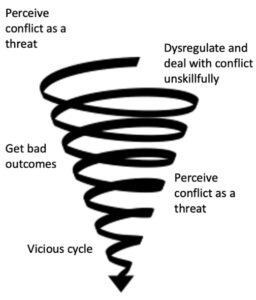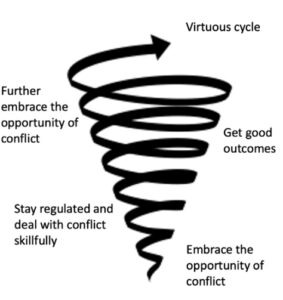
In my last blog, I described what conflict competence is and summarized the key conflict competencies that empower us to deal with conflict skillfully and productively. In this blog, I build on those ideas to explore the choices we make when dealing with conflict and the way in which different choices lead to very different outcomes. More specifically, I explain the destructive conflict tendencies we often default to and the productive conflict choices we can make instead.
Before I dive in, it is important to be clear about what conflict is and is not. Conflict is simply the intersection of different perspectives, ideas, wants, or needs that are in tension with each other and not easily reconciled. As I’ve discussed in prior blogs, if dealt with skillfully, conflict provides opportunities for positive change and growth. Unfortunately, when not dealt with skillfully, conflict tends to result in negative outcomes such as arguing, fighting, or outright war.
Importantly, these detrimental outcomes are not conflict; they are the result of failing to deal with conflict productively. Or, in other words, they are the result of people choosing to respond to conflict poorly.
Which leads me to the first point…
We have a choice about how we respond to conflict—and how we choose to respond matters
Whether or not we realize it, we always have the power to choose how we respond to any stimulus, including conflict. As Viktor Frankl supposedly said: “Between stimulus and response there is a space. In that space is our power to choose our response. In our response lies our growth and our freedom.”
When we take responsibility (or, perhaps more aptly, “response-ability”) for our choices when dealing with conflict, we can choose to become more conflict-competent and to respond to conflict productively. When we do so, we are much more likely to create productive outcomes from conflict, which in turn makes it easier to respond to conflict the next time we encounter it. This dynamic results in what I refer to as an “upward spiral of productive conflict.”
Unfortunately, many of us do not realize that we have a choice about how we respond to conflict and, even if we do, we have not learned how to respond to conflict skillfully. As a result, we tend to default to destructive conflict tendencies. And, as I explore below, choosing to default to those tendencies typically results in negative outcomes, leading to what I call the “downward spiral of destructive conflict.”
Destructive conflict tendencies and the downward spiral of destructive conflict
For various innate and socialized reasons I have explored in past blogs, people tend to see conflict as a problem. This is in large part because we tend to see the world and conflict as a zero-sum game, meaning for one person to do well, others must lose. Therefore, we perceive conflict as a threat and, when we encounter conflict, we focus on trying to win, or at least not lose. This is what I refer to as a destructive mindset around conflict.
This destructive mindset around conflict, if not addressed, leads to the following predictable set of destructive behaviors:
- We tend to get dysregulated when we encounter conflict, since we perceive conflict as a threat;
- When we dysregulate, our amygdala (i.e., our “lizard brain”) takes over, we go into fight, flight, freeze, or appease mode in an effort to protect ourselves, and we default to defend-and-attack behaviors;
-

Downward spiral of destructive conflict As part of this, we tend to make the conflict very personal (i.e., this is about you versus me) rather than focusing on working together to problem solve and address the issue that brought us into conflict in the first place; and
- Because we feel threatened and get focused on “winning” rather than problem-solving, we get fixated on achieving certain solutions or outcomes (i.e., “positions”) and, in so doing, lose sight of our fundamental needs and concerns (i.e., our “interests”).
The result of this destructive mindset and set of behaviors is almost always negative outcomes for most if not all parties, including hurt feelings, degraded relationships, reduced ability to work together in the future, erosion of trust, and ineffective solutions. These negative outcomes tend to reinforce our belief that conflict is bad. And that creates a vicious cycle where we continue to see conflict as a threat and we continue to dysregulate and behave unskillfully when we encounter conflict. This is the downward spiral of destructive conflict.
Productive conflict choices and the upward spiral of productive conflict
If we take responsibility for the fact that we choose how we deal with conflict (i.e., that we have response-ability), we can choose to make productive conflict choices instead of defaulting to destructive conflict tendencies. A first step in doing so is to shift our mindset around conflict to stop seeing conflict as bad and instead embrace the fact that conflict, if skillfully handled, is an opportunity for positive change. To do this, we need to shift away from seeing the world and conflict through a scarcity lens (i.e., “there isn’t enough to go around!”) to instead accept that the world and conflict are not inherently win-lose and that we can create value through working together. That, in turn, enables us to step out of our fear of losing, stay regulated, and focus on working with other involved parties to create value and get to a good outcome.

When we approach conflict in this skillful way, it empowers us to shift how we behave and to act in much more productive ways when we experience conflict, mainly:
- When we stay neurologically regulated when dealing with conflict, this makes it possible for us to respond to the situation thoughtfully and act intentionally rather than defaulting to defend-and-attack behaviors;
- This allows us to approach conflict with a curious and compassionate stance and to focus on learning and trying to understand what the problem really is and what we and others really need; and
- When we do this, we can work with others to “attack the problem” rather than “attacking the people”—i.e., we can work with other parties to create mutual gains solutions, rather than making the situation personal and focusing on “being right” or “winning.”
Approaching conflict this way and working with others to co-create solutions and strategies that meet the core needs of all involved parties results in all sorts of positive outcomes, from improved relationships to learning about ourselves and others to creating innovative solutions that are better than the solutions any one party would have come up with on their own. In other words, conflict becomes highly productive. When this happens, it creates a virtuous cycle where it becomes easier to meet future conflicts with a calm, open state of mind and skillfulness. This is the upward spiral of productive conflict.
The table below provides a summary of our destructive conflict tendencies and the productive conflict choices we can make instead, along with the results of those choices.
Summary of destructive conflict tendencies and productive conflict choices
| Destructive Conflict Tendencies | Productive Conflict Choices | |
| Mindset | See conflict as bad | See that conflict “just is” and that it can be an opportunity if skillfully handled |
| See the world and conflict as zero-sum (i.e., scarcity mindset) | See the world and conflict as non-zero sum (i.e., abundance mindset) | |
| See the goal as to win or at least not lose | See the goal as to problem solve and create a good outcome | |
| Behaviors | Dysregulate and react | Regulate and respond |
| Defend and attack (i.e., fear stance) | Seek to learn and understand (i.e., curious compassionate stance) | |
| Make it personal (i.e., attack the people) | Strive to create mutual gains (i.e., attack the problem) | |
| Focus on winning (i.e., focus on getting specific solutions, or what we call “positions”) | Focus on what really matters (i.e., meeting fundamental needs or concerns, or what we call “interests”) | |
| Results | Negative outcomes | Positive outcomes |
| Reinforcement of the perception that conflict is a problem | Reinforcement of the perception that conflict is an opportunity if skillfully handled | |
| Decreased ability to productively deal with future conflict (i.e., spiral of destructive conflict) | Improved ability to productivity deal with future conflict (i.e., upward spiral of productive conflict) |
How do you choose to deal with conflict?
Through shifting our mindset around conflict to embrace the fact that conflict just is and that it can be a positive thing if skillfully handled, we can empower ourselves and others to make more skillful choices about how we act when faced with conflict. Doing so not only helps us avoid the destructive spiral of downward conflict, but it also helps us create better results and get into the upward spiral of productive conflict.
As you move through life, I encourage you to become aware of how you think about and tend to behave when dealing with conflict. Are you defaulting to destructive conflict tendencies? If so, how can you shift toward making productive conflict choices?
 Danya Rumore, Ph.D., is the director of the Environmental Dispute Resolution program in the Wallace Stegner Center at the University of Utah. She is a research professor in the S.J. Quinney College of Law and a clinical associate professor in the city and metropolitan planning department at the University of Utah. She teaches about, practices, and conducts research on conflict, negotiation, dispute resolution, leadership, and collaborative problem solving. She is also the founder and a co-director of the Gateway and Natural Amenity Region (GNAR) Initiative.
Danya Rumore, Ph.D., is the director of the Environmental Dispute Resolution program in the Wallace Stegner Center at the University of Utah. She is a research professor in the S.J. Quinney College of Law and a clinical associate professor in the city and metropolitan planning department at the University of Utah. She teaches about, practices, and conducts research on conflict, negotiation, dispute resolution, leadership, and collaborative problem solving. She is also the founder and a co-director of the Gateway and Natural Amenity Region (GNAR) Initiative.
About the EDR blog: Hosted by the Wallace Stegner Center’s Environmental Dispute Resolution (EDR) program, the EDR blog shares ideas, tools, and resources to cultivate a culture of collaboration and help readers be more skillful in working through conflict. Read additional blog posts at edrblog.org.
